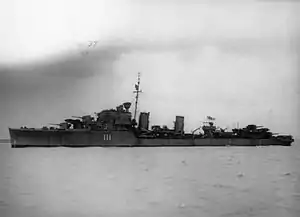HMS Impulsive (D11)
HMS Impulsive was an I-class destroyer built for the Royal Navy during the 1930s. She has been the only ship of the Navy to bear this name.
 Impulsive | |
| History | |
|---|---|
| Name: | Impulsive |
| Builder: | J. Samuel White and Company, Cowes |
| Laid down: | March 1936 |
| Launched: | 1 March 1937 |
| Commissioned: | 29 January 1938 |
| Identification: | Pennant number: D11 |
| Fate: | Scrapped, 1946 |
| General characteristics (as built) | |
| Class and type: | I-class destroyer |
| Displacement: | |
| Length: | 323 ft (98.5 m) |
| Beam: | 33 ft (10.1 m) |
| Draught: | 12 ft 6 in (3.8 m) |
| Installed power: |
|
| Propulsion: | 2 shafts, 2 geared steam turbines |
| Speed: | 35.5 knots (65.7 km/h; 40.9 mph) |
| Range: | 5,500 nmi (10,200 km; 6,300 mi) at 15 knots (28 km/h; 17 mph) |
| Complement: | 145 |
| Sensors and processing systems: | ASDIC |
| Armament: |
|
| Service record | |
| Commanders: | Lt. Cmdr. William Scott Thomas |
| Victories: | Sank U-457 (1942) |
Description
The I-class ships were improved versions of the preceding H-class. They displaced 1,370 long tons (1,390 t) at standard load and 1,888 long tons (1,918 t) at deep load. The ships had an overall length of 323 feet (98.5 m), a beam of 33 feet (10.1 m) and a draught of 12 feet 6 inches (3.8 m). They were powered by two Parsons geared steam turbines, each driving one propeller shaft, using steam provided by three Admiralty three-drum boilers. The turbines developed a total of 34,000 shaft horsepower (25,000 kW) and were intended to give a maximum speed of 35.5 knots (65.7 km/h; 40.9 mph).[1] Impulsive only reached a speed of 32.2 knots (59.6 km/h; 37.1 mph) from 33,297 shp (24,830 kW) during her sea trials.[2] The ships carried enough fuel oil to give them a range of 5,500 nautical miles (10,200 km; 6,300 mi) at 15 knots (28 km/h; 17 mph). Their crew numbered 145 officers and ratings.[1]
The ships mounted four 4.7-inch (120 mm) Mark IX guns in single mounts, designated 'A', 'B', 'X' and 'Y' from bow to stern. For anti-aircraft (AA) defence, they had two quadruple mounts for the 0.5 inch Vickers Mark III machine gun. The I class was fitted with two above-water quintuple torpedo tube mounts for 21-inch (533 mm) torpedoes.[3] One depth charge rack and two throwers were fitted; 16 depth charges were originally carried,[1] but this increased to 35 shortly after the war began.[4] Impulsive was one of the four I-class destroyers fitted with minelaying equipment in late 1938 – January 1939 at Malta. This consisted of mounts for rails on the deck on which to carry the mines and an electric winch to move the mines down the rails. A pair of sponsons were added to the stern to allow the mines to clear the propellers when dropped into the sea. 'A' and 'Y' guns and both sets of torpedo tubes were modified to allow them to be removed to compensate for the weight of the mines.[5] The ships could carry a maximum of 72 mines.[6] The I-class ships were fitted with the ASDIC sound detection system to locate submarines underwater.[7]
Construction and career
Impulsive was laid down on 9 March 1936 by J. Samuel White and Company at their Cowes shipyard, launched on 1 March 1937 and completed on 29 January 1938. 28th and 29th May 1940 she made two trips to Dunkirk and rescued 2,917 troops. She attacked and sank the German submarine U-457 in the Barents Sea north-east of Murmansk in Russia on 16 September 1942.
Impulsive was sold for scrap to W. H. Arnott, Young and Company, Limited on 22 January 1946 and broken up at Sunderland.
Notes
- Lenton, p. 161
- March, p. 315
- Whitley, p. 111
- English, p. 141
- Smith, pp. 112–113
- Friedman, p. 230
- Hodges & Friedman, p. 16
Bibliography
- Colledge, J. J.; Warlow, Ben (2006) [1969]. Ships of the Royal Navy: The Complete Record of all Fighting Ships of the Royal Navy (Rev. ed.). London: Chatham Publishing. ISBN 978-1-86176-281-8.
- English, John (1993). Amazon to Ivanhoe: British Standard Destroyers of the 1930s. Kendal, England: World Ship Society. ISBN 0-905617-64-9.
- Friedman, Norman (2006). British Destroyers & Frigates: The Second World War and After. Annapolis, Maryland: Naval Institute Press. ISBN 1-86176-137-6.
- Haarr, Geirr H. (2010). The Battle for Norway: April–June 1940. Annapolis, MD: Naval Institute Press. ISBN 978-1-59114-051-1.
- Haarr, Geirr H. (2009). The German Invasion of Norway, April 1940. Annapolis, Maryland: Naval Institute Press. ISBN 978-1-59114-310-9.
- Hodges, Peter & Friedman, Norman (1979). Destroyer Weapons of World War 2. Greenwich: Conway Maritime Press. ISBN 978-0-85177-137-3.
- Lenton, H. T. (1998). British & Empire Warships of the Second World War. Annapolis, Maryland: Naval Institute Press. ISBN 1-55750-048-7.
- March, Edgar J. (1966). British Destroyers: A History of Development, 1892-1953; Drawn by Admiralty Permission From Official Records & Returns, Ships' Covers & Building Plans. London: Seeley Service. OCLC 164893555.
- Rohwer, Jürgen (2005). Chronology of the War at Sea 1939–1945: The Naval History of World War Two (Third Revised ed.). Annapolis, Maryland: Naval Institute Press. ISBN 1-59114-119-2.
- Smith, Peter C. (2005). Into the Minefields: British Destroyer Minelaying 1918–1980. Barnsley, UK: Pen & Sword Books. ISBN 1-84415-271-5.
- Whitley, M. J. (1988). Destroyers of World War Two: An International Encyclopedia. Annapolis, Maryland: Naval Institute Press. ISBN 0-87021-326-1.
- Winser, John de D. (1999). B.E.F. Ships Before, At and After Dunkirk. Gravesend, Kent: World Ship Society. ISBN 0-905617-91-6.